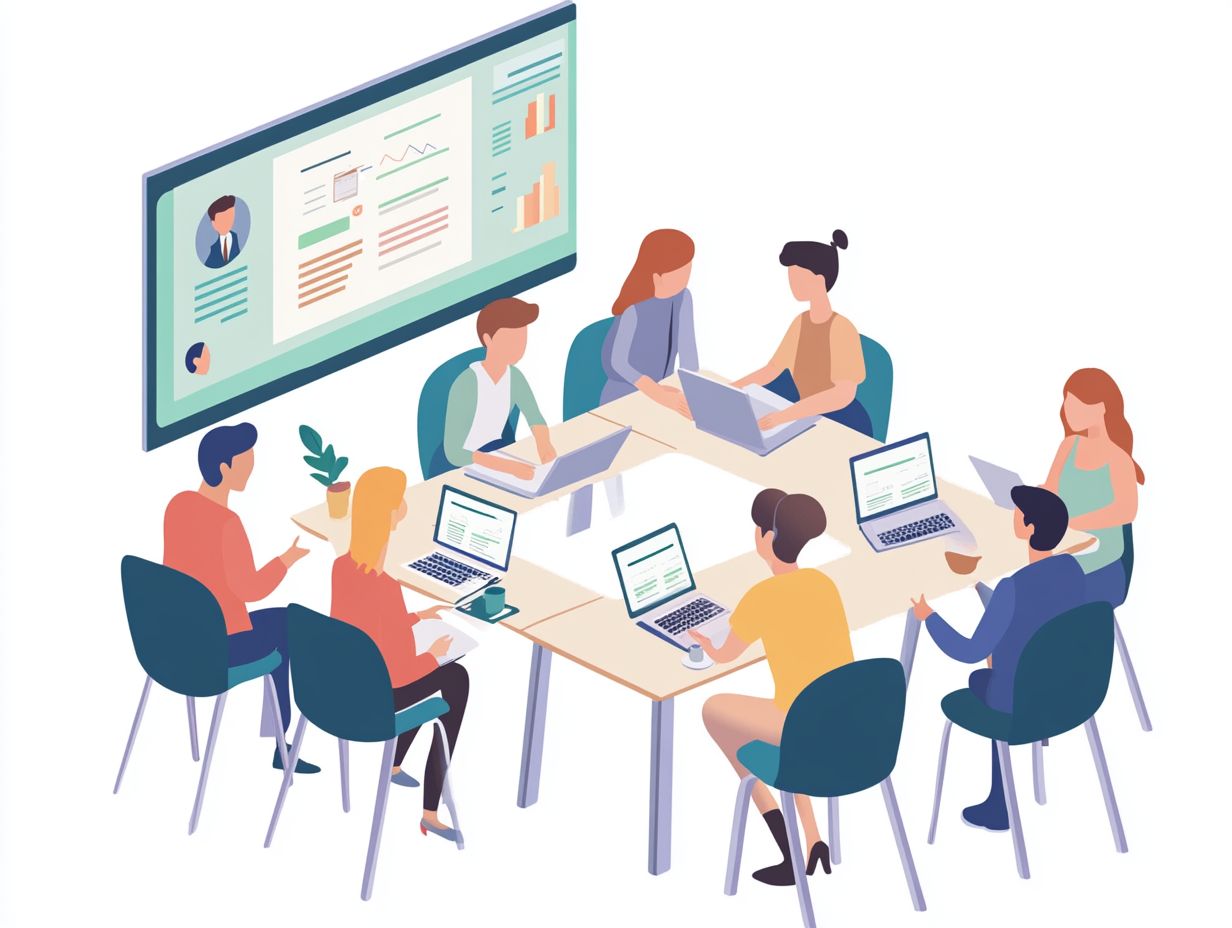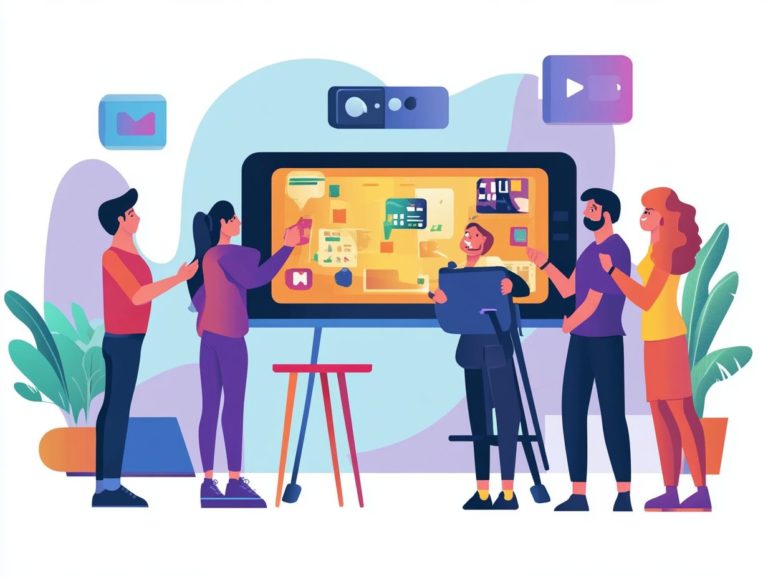What Is Blended Learning in Corporate Training?
In today’s fast-paced corporate landscape, blended learning has emerged as a compelling approach to training that seamlessly integrates traditional face-to-face instruction with online learning.
This article delves into the definition and key components of blended learning. It showcases the myriad benefits it provides, including enhanced learning outcomes and cost efficiency.
You ll find best practices for implementing this approach successfully, address common challenges, and explore strategies for evaluating the effectiveness of your training programs.
Uncover how blended learning can revolutionize your corporate training initiatives.
Contents
- Key Takeaways:
- Understanding Blended Learning
- Benefits of Blended Learning in Corporate Training
- Best Practices for Implementing Blended Learning
- Challenges and Solutions for Blended Learning in Corporate Training
- Evaluating the Effectiveness of Blended Learning
- Frequently Asked Questions
- What Is Blended Learning in Corporate Training?
- How does Blended Learning in Corporate Training work?
- What are the benefits of using Blended Learning in Corporate Training?
- What types of activities can be included in Blended Learning in Corporate Training?
- How can organizations implement Blended Learning in Corporate Training?
- What are the potential challenges of using Blended Learning in Corporate Training?
Key Takeaways:

- Blended learning combines traditional classroom learning with online resources, providing a more flexible and effective corporate training approach.
- The benefits of blended learning include improved learning outcomes and cost-effectiveness for companies.
- To successfully implement blended learning, companies should develop a plan, choose the right technologies, and address challenges such as resistance and technical issues.
Understanding Blended Learning
Blended learning is a modern method to education, merging traditional face-to-face instruction with contemporary online learning techniques.
This creates a flexible learning environment tailored to accommodate diverse learning styles and preferences.
In the realm of corporate training, blended learning is gaining massive popularity! Organizations adopt blended learning models to elevate their employee training programs and boost overall learner engagement.
Using different teaching methods helps everyone learn better. By incorporating multimedia resources and gamification elements, businesses can cultivate a more effective learning culture.
This enhances knowledge retention and addresses the varied needs of their workforce.
Definition and Components
Blended learning is an educational approach that combines traditional face-to-face training with online learning opportunities, creating a versatile and engaging experience for you.
At the heart of this method lies a learning management system (LMS), a tool to manage your online courses. You ll encounter various blended learning models designed to facilitate adaptive and individualized learning paths tailored to your needs.
Integrating online assessments enhances the experience. They offer you instant feedback and enable instructors to gauge your understanding effectively.
The in-person component fosters a sense of community and collaboration among learners like yourself, encouraging deeper discussions and meaningful connections.
As you progress through tailored lessons, you can engage with materials at your own pace. This ultimately leads to improved retention and a more rewarding educational experience.
Benefits of Blended Learning in Corporate Training
The integration of blended learning in corporate training offers you a wealth of advantages.
It can enhance learning outcomes and maximize the cost-effectiveness of your training programs.
By leveraging this approach, organizations can craft engaging and interactive training experiences. These ensure employees don t just absorb knowledge but also apply it effectively in their roles.
This dual emphasis on efficiency and effectiveness translates to a significant return on investment for your business.
It nurtures a culture of continuous improvement and professional development.
Start implementing blended learning today and see the difference it makes!
Improved Learning Outcomes
One of the primary advantages of adopting blended learning is the substantial enhancement in your learning outcomes. This approach engages you more deeply by combining interactive content and multimedia resources. By using tailored assessment strategies and adaptive learning, organizations can ensure that you grasp essential concepts and retain knowledge effectively, leading to a significant boost in overall training effectiveness.
This model combines face-to-face instruction and online resources, granting you the flexibility to access information in a way that suits your personal learning style. Incorporating engagement techniques like gamification, collaborative projects, and real-time feedback encourages you to actively participate, keeping your motivation levels high.
Adaptive learning technologies adjust the material based on your individual progress, allowing you to advance at your own pace. Effective assessment strategies, including formative assessments and regular quizzes, do more than just evaluate your understanding; they reinforce your learning, leading to improved retention of knowledge and skills. Ultimately, this equips you for practical application in your role, setting you up for success.
Cost-Effectiveness

Blended learning presents a cost-effective solution for your corporate training needs, enabling your organization to significantly reduce training expenses while maximizing return on investment. By minimizing reliance on extensive face-to-face training and utilizing the strength of digital resources, you can allocate your resources more efficiently, providing accessible training opportunities for your employees.
The financial advantages extend to cutting down travel expenses. Many training sessions can be conducted online, saving you on accommodation and transportation costs. For example, a major technology firm that adopted a blended learning strategy experienced a remarkable 30% decrease in training costs while achieving higher engagement rates among participants.
The scalable nature of blended learning allows you to easily reuse and update materials, ensuring that your training remains relevant without incurring additional expenses. This approach enhances the quality of training and fosters a more sustainable model that can adapt to various organizational needs, ultimately driving stronger ROI in the long run.
Best Practices for Implementing Blended Learning
To implement a successful blended learning strategy, engage in meticulous planning and choose the right technologies that align with your specific training goals. Develop a comprehensive plan detailing how you will integrate a learning management system (LMS) a platform that helps manage and deliver training online with various instructional methods.
This ensures that your resources are allocated effectively and that everything aligns seamlessly with your desired learning outcomes. By taking this thoughtful approach, you ll streamline the implementation process and significantly enhance the overall effectiveness of your corporate training initiatives.
Developing a Plan
Developing a comprehensive plan for blended learning requires you to clearly define training objectives and align them with the workforce’s needs. Ensure that learner support mechanisms are integrated throughout the process to help your organization allocate resources effectively and maximize the impact of its training programs.
Start by assessing the current skills and knowledge gaps within your organization. Tailor the learning experience to accommodate diverse learner profiles, ensuring everyone benefits. Implementing robust support structures, such as mentorship and access to digital resources, will enhance overall engagement.
Never underestimate the importance of continual evaluation. Regular feedback loops allow you to make real-time adjustments, ensuring that the training remains relevant and effective. By fostering an adaptive environment, you can cultivate a culture of continuous improvement, ultimately elevating both employee satisfaction and overall performance.
Choosing the Right Technologies
Selecting the right technologies is essential for successful blended learning. This choice enables effective delivery of training content and fosters collaboration among employees.
By leveraging a suitable learning management system (LMS) and collaboration tools, you can enhance learner engagement and streamline the learning process.
Consider the specific needs of your organization and workforce. Identifying tools with intuitive user interfaces, easy to use with other systems, and strong data analysis features can significantly impact your outcomes.
Collaboration tools play a vital role in promoting interaction and peer learning, elevating the overall training experience.
Choosing the right digital tools wisely supports your blended learning strategies and contributes to a more interactive and efficient educational environment, enhancing training outcomes and boosting employee satisfaction.
Challenges and Solutions for Blended Learning in Corporate Training
Blended learning offers a wealth of advantages, but it also brings challenges, especially regarding implementation and gaining learner acceptance.
You may encounter resistance from employees comfortable with traditional training methods, along with technical hurdles tied to digital tools. Addressing these concerns ensures a smoother transition to blended learning models while keeping learner motivation high.
Overcoming Resistance

Overcoming resistance to blended learning is crucial for its successful implementation. It cultivates a positive training culture that fosters adaptation and growth.
Engage employees in the process and showcase the benefits of blended learning to enhance learner motivation and alleviate apprehensions about new methodologies.
Maintain open communication about the advantages and logistics of blended learning. This clarifies the process and eases fears.
Provide comprehensive training sessions to ensure everyone feels confident navigating new platforms. Involving employees and seeking their input makes them feel valued and strengthens their commitment to the transition.
Nurture a culture that celebrates continuous learning, encouraging team members to view change as an opportunity for professional development rather than a challenge.
Tackling Tech Troubles: Ensuring Smooth Learning
Addressing technical issues is essential for implementing blended learning effectively. These challenges can disrupt the learning experience and disengage employees from training.
Organizations must act quickly to create strong support systems that assist learners in navigating digital tools and resolving technical hurdles.
This proactive strategy minimizes disruptions and cultivates a learning environment where employees feel enabled and supported.
Common hurdles, such as connectivity problems, unfamiliarity with learning management systems, or incompatible devices, highlight the importance of having a clear troubleshooting guide and accessible resources.
By offering comprehensive training sessions and ongoing technical assistance, organizations can alleviate anxiety surrounding technology. Creating a supportive community through discussion forums or peer mentoring systems enhances collaboration and ensures learners have access to help whenever needed, promoting a more seamless training experience.
Evaluating the Effectiveness of Blended Learning
Evaluating the effectiveness of blended learning is crucial for ensuring that your training programs achieve their objectives and yield meaningful results.
By measuring learning outcomes through a range of assessment strategies and gathering feedback from participants, you can gain valuable insights into the success of your blended learning initiatives.
This process highlights what s working well and identifies areas ripe for improvement, allowing you to refine your approach and enhance the overall learning experience.
Measuring Learning Outcomes
Measuring learning outcomes is essential for evaluating blended learning, as it offers valuable insights into how effectively you have acquired and retained knowledge. By employing a variety of assessment strategies (methods for evaluating learning), organizations can accurately gauge the effectiveness of training and identify areas ripe for enhancement.
Quizzes act as a swift and efficient way to test your knowledge retention. They enable trainers to pinpoint specific topics that might need a bit more attention.
On the other hand, projects provide a more holistic evaluation, encouraging you to apply learned concepts in real-world scenarios. This approach deepens your understanding.
Incorporating interactive assessments, such as simulations or group discussions, promotes engagement and collaboration among employees. This offers crucial feedback on your grasp of the material. Together, these evaluation methods not only assess individual performance but also paint a clearer picture of the program’s overall impact on knowledge retention and its practical application in the workplace.
Gathering Feedback from Participants
Gathering feedback from participants is crucial for improving blended learning initiatives and ensuring high levels of engagement throughout the training process. By seeking input from employees about their experiences, you can pinpoint strengths and weaknesses, leading to actionable improvements in training effectiveness.
This feedback loop guides curriculum adjustments and elevates the overall learning experience.
Try these effective methods to capture feedback:
- Structured surveys that quantify satisfaction levels
- In-depth interviews that unveil deeper insights
- Casual, informal discussions that encourage spontaneous reflections
Each approach offers unique advantages and caters to different participant preferences. By actively engaging with learners and incorporating their feedback into program development, you foster a culture of continuous improvement.
This commitment significantly enhances the effectiveness of your blended learning programs and boosts overall participant satisfaction, ultimately cultivating a more competent and motivated workforce.
Frequently Asked Questions

What Is Blended Learning in Corporate Training?
Blended Learning combines classroom teaching with online methods for a dynamic training experience.
How does Blended Learning in Corporate Training work?
Blended Learning typically involves a mix of face-to-face instruction, self-paced online modules, and interactive activities to enhance the learning experience.
What are the benefits of using Blended Learning in Corporate Training?
Blended Learning offers a flexible and engaging experience for employees, allowing them to learn at their own pace and in various formats. This can lead to increased knowledge retention and improved performance.
What types of activities can be included in Blended Learning in Corporate Training?
Blended Learning can include a variety of activities such as lectures, discussions, simulations, online quizzes, virtual role-playing, and group projects to provide a well-rounded learning experience for employees.
How can organizations implement Blended Learning in Corporate Training?
Organizations can implement Blended Learning by partnering with professional trainers or instructional designers to create customized training programs that incorporate both traditional and online learning methods. They can also utilize learning management systems to deliver and track the training.
What are the potential challenges of using Blended Learning in Corporate Training?
Some potential challenges include the need for proper technology and infrastructure, ensuring employee engagement and motivation, and the necessity for ongoing evaluation and updates to the training program.





